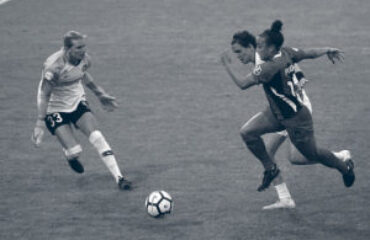THEORETICAL FRAMEWORK
Linear sprint, change of direction (COD), and vertical jump performances play key roles in soccer. These capabilities can be improved through the use of various training strategies (Salaj and Markovic, 2011). Among the different approaches, resisted sprint training (RST) has been shown to be an effective method for enhancing physical performance (Alcaraz et al., 2018). There are different types of RST, and the main difference between them is the direction of the applied resistance (e.g., vertical or horizontal) (Alcaraz et al., 2008). RST allows the production of substantial amounts of force at high velocities, thus inducing functional enhancements in different explosive actions (e.g., jumping, sprinting, COD) (Suchomel et al., 2016). Specific performance also relies on the ability to apply these forces with orientations similar to those required by the mechanical demands of the task (Sale, 1981). Therefore, it is probable that both vertically (using weighted vests) and horizontally (using a portable robotic resistance device) overloaded RST, and the combination of both, may improve the physical performance of soccer players.
STUDY OBJECTIVES
The purpose of the study was to analyze and compare the effects of different RST modalities (e.g., vertically- and horizontally-oriented RST) with loads ranging from 10 to 20% of the body-mass (BM) on the performance of youth soccer players after 8 weeks of linear and COD sprint training.
MAIN RESULTS
After analyzing the changes in physical performance after 8-weeks of vertical, horizontal, or combined (vertical + horizontal) RST, and unresisted sprint training in 60 youth soccer players, the authors observed that:
- 8 weeks of different RST (vertical, horizontal, and combined RST) strategies improved linear sprint, COD, and horizontal jump performances.
- Only the vertically-oriented RST was capable of increasing vertical jump height.
- Between-group comparisons revealed that vertically-oriented RST could promote greater improvements in sprint, COD, and countermovement jump abilities.
CONCLUSIONS
The application of both horizontal and vertical resistance in RST may improve sprint, COD, and jump performances. A vertically-oriented load (with weighted vests) promoted the greatest improvements in both sprint and COD ability and had a positive additional effect on vertical jump height.
FSI STATEMENTS
- The use of RST strategies is effective to improve speed and power-related capacities in youth soccer players.
- Coaches and practitioners can use distinct approaches by varying the orientation of the resistance applied (vertical or horizontal) and the relative load (10-20% of body mass) when implementing RST programs.
- 8 weeks of RST performed twice a week seem to be sufficient to promote meaningful performance improvements.
- The use of weighted vests allows players to properly perform COD drills, while “horizontally-oriented devices” may be more adequate to execute linear sprints.
Salaj, S., & Markovic, G. (2011). Specificity of jumping, sprinting, and quick change-of-direction motor abilities. The Journal of Strength & Conditioning Research, 25(5), 1249-1255.
Alcaraz, P. E., Carlos-Vivas, J., Oponjuru, B. O., & Martinez-Rodriguez, A. (2018). The effectiveness of resisted sled training (RST) for sprint performance: a systematic review and meta-analysis. Sports Medicine, 48(9), 2143-2165.
Alcaraz, P. E., Palao, J. M., Elvira, J. L., & Linthorne, N. P. (2008). Effects of three types of resisted sprint training devices on the kinematics of sprinting at maximum velocity. The Journal of Strength & Conditioning Research, 22(3), 890-897.
Sale, D. (1981). Specificity in strength training: a review for the coach and athlete. Can. J. Appl. Sport Sci., 6, 87-92.
Suchomel, T. J., Nimphius, S., & Stone, M. H. (2016). The importance of muscular strength in athletic performance. Sports medicine, 46(10), 1419-1449.





